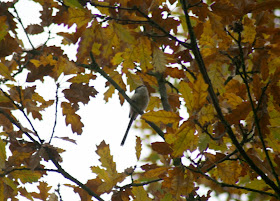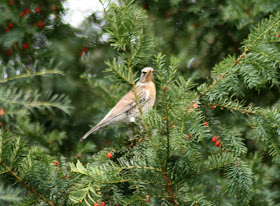 |
| Every once in a while I get a lucky shot with my Canon, this is one of those lucky shots |
The Red-tailed Hawk most common and often seen of the Buteos here along the Wasatch Front, if you watch the power poles along any freeway or highway in Northern Utah you are likely to see at least one Red-tailed Hawk perched sitting and waiting for a mouse, meadow vole or other easy prey to dive down on.
My first recollection of a Red-tailed hawk which everyone back then called a chicken hawk, was when I was a child maybe seven or eight years old and our neighbor across the street the mighty hunter came home from a hunting trip with a Red-tail he had shot and wounded. Of course all the boys in the neighborhood were curious and excited, to see this "chicken hawk". His intent was to give it to a couple of brothers in our neighborhood to keep as a pet. I was the first to attempt to pick up this scared and angry bird not realizing how sharp it was. He promptly sliced my finger with his razor sharp talons ending my desire to hold it.
I have thought about that many times in the past 40 plus years and realized how much the world has changed. Just imagine a man bringing home a hawk he had shot and wounded which is illegal and carries a great fine and punishment but then to allow small children to then play with it. This would now be considered animal cruelty, poaching, and above all irresponsible to the animal and to the children.
I don't remember what ended up happening to that hawk but I do know it was one of the experiences in my life that lead to my respect, interest in and love for birds.
I don't remember what ended up happening to that hawk but I do know it was one of the experiences in my life that lead to my respect, interest in and love for birds.
Red-tails are year round residents in Utah and many are hatched each year at and around Farmington Bay. All of these pictures were taken at Farmington Bay.
Size & Shape
Red-tailed Hawks are large hawks with typical Buteo proportions: very broad, rounded wings and a short, wide tail. Large females seen from a distance might fool you into thinking you’re seeing an eagle. (Until an actual eagle comes along.)Color Pattern
Most Red-tailed Hawks are rich brown above and pale below, with a streaked belly and, on the wing underside, a dark bar between shoulder and wrist. The tail is usually pale below and cinnamon-red above, though in young birds it’s brown and banded. “Dark-phase” birds are all chocolate-brown with a warm red tail. “Rufous-phase” birds are reddish-brown on the chest with a dark belly.Behavior
You’ll most likely see Red-tailed Hawks soaring in wide circles high over a field. When flapping, their wingbeats are heavy. In high winds they may face into the wind and hover without flapping, eyes fixed on the ground. They attack in a slow, controlled dive with legs outstretched – much different from a falcon’s stoop.Habitat
The Red-tailed Hawk is a bird of open country. Look for it along fields and perched on telephones poles, fenceposts, or trees standing alone or along edges of fields.

Similar Species
The first step with identifying any hawk is to use its size and shape to decide what type you're looking at. Is it one of the three main groups: buteo, accipiter, or falcon? Buteos have broad, rounded wings and short, wide tails, and you often see them soaring without flapping. Red-shouldered Hawks, another common buteo, tend to be smaller than Red-tails with a banded tail and warm brown barring below. Swainson's Hawk has a dark trailing edge to the underside of the wing, and a dark chest. From a distance you might confuse a soaring Red-tail with aTurkey Vulture (also very common across North America in summer), but Turkey Vultures have longer, more rectangular wings, which the birds hold above horizontal, forming an easily visible V. Turkey Vultures are also much less steady when they soar.
Red-tailed Hawks have extremely variable plumage, and some of this variation is regional. A Great Plains race called "Krider's" hawk is pale, with a whitish head and washed-out pink in the tail. Light-phase western birds tend to be more streaky on the underparts than eastern Red-tails; south Texas forms are darker above, without the dark belly band most other Red-tails have. Dark-phase birds can occur anywhere but are more common in western North America - particularly in Alaska and northwest Canada, where the all-dark "Harlan's" race is common.
 |
| Dining on a muskrat |
The Red-tailed Hawk has a thrilling, raspy scream that sounds exactly like a raptor should sound. At least, that’s what Hollywood directors seem to think. Whenever a hawk or eagle appears onscreen, no matter what species, the shrill cry on the soundtrack is almost always a Red-tailed Hawk.
 |
| This could have been so much better my only opportunity so far to shoot a dark morph Red-tail and my camera acted up, fortunately I at least got this less than wonderful shot |



































